Supply Chain Management for Shell in Gas Market: Challenges and Opportunities
VerifiedAdded on 2023/06/12
|13
|2940
|290
AI Summary
This report discusses the potentiality of supply chain management for Shell in entering the gas market. It identifies the target market, suitable gas products, transportation modes, hazards, and challenges. It also recommends steps to overcome the identified challenges.
Contribute Materials
Your contribution can guide someone’s learning journey. Share your
documents today.
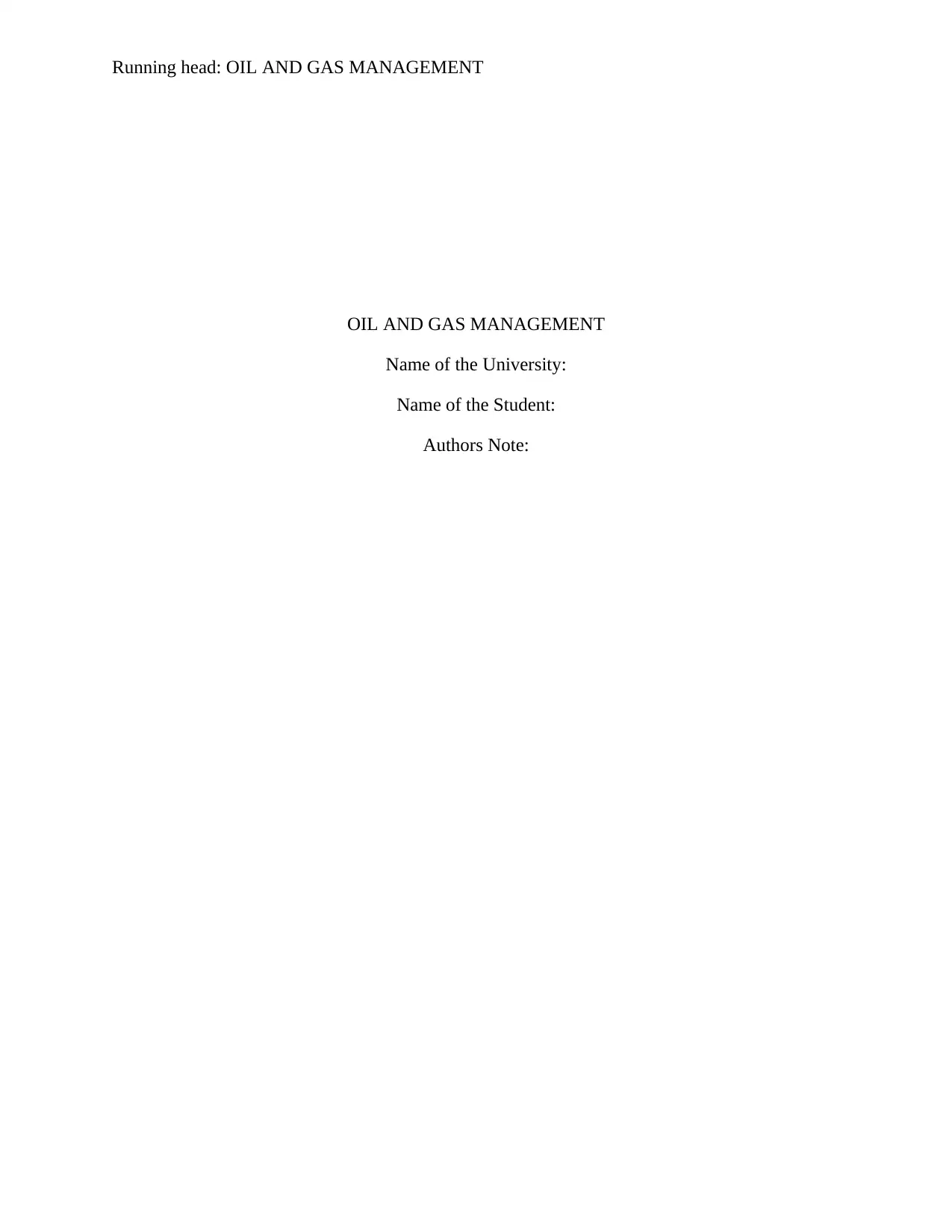
Running head: OIL AND GAS MANAGEMENT
OIL AND GAS MANAGEMENT
Name of the University:
Name of the Student:
Authors Note:
OIL AND GAS MANAGEMENT
Name of the University:
Name of the Student:
Authors Note:
Secure Best Marks with AI Grader
Need help grading? Try our AI Grader for instant feedback on your assignments.
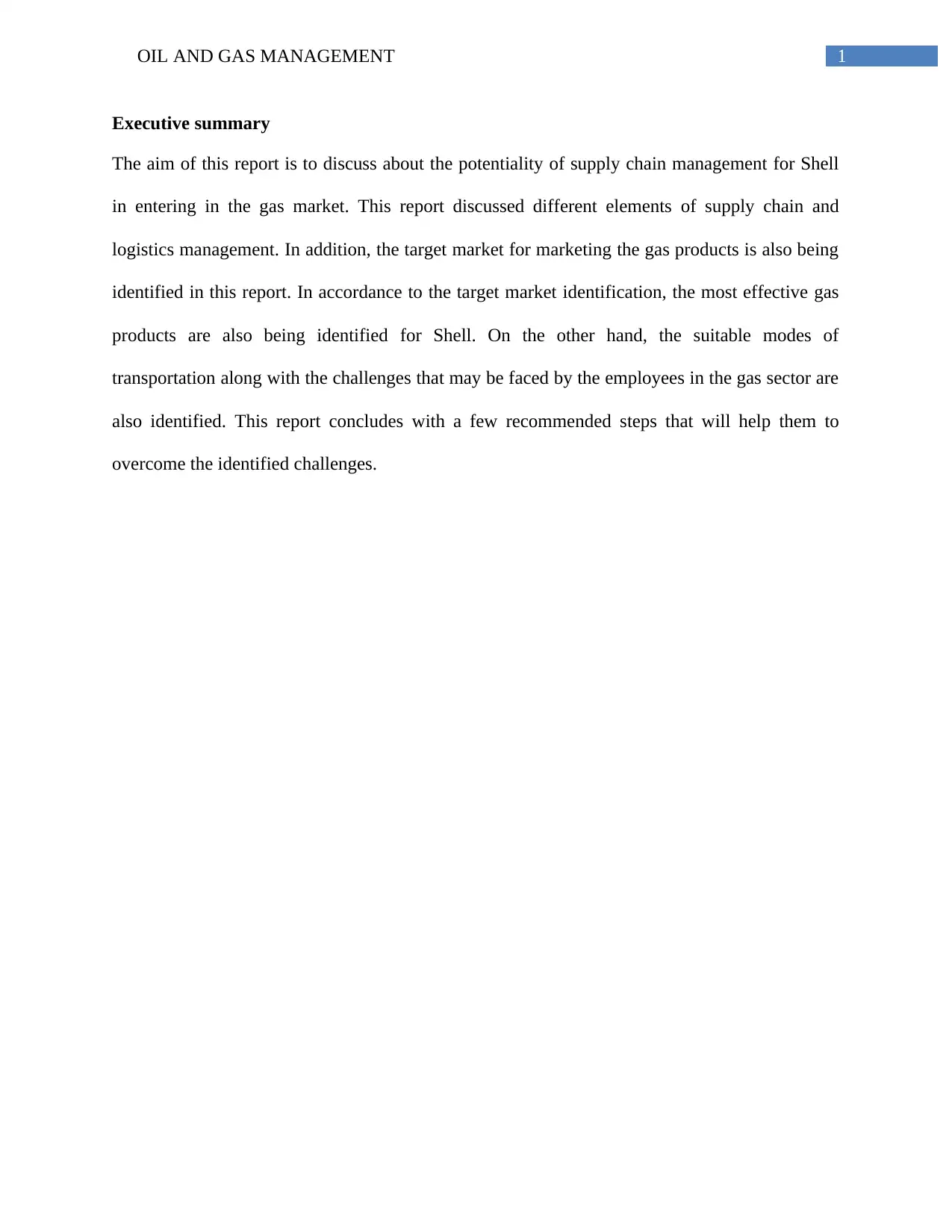
1OIL AND GAS MANAGEMENT
Executive summary
The aim of this report is to discuss about the potentiality of supply chain management for Shell
in entering in the gas market. This report discussed different elements of supply chain and
logistics management. In addition, the target market for marketing the gas products is also being
identified in this report. In accordance to the target market identification, the most effective gas
products are also being identified for Shell. On the other hand, the suitable modes of
transportation along with the challenges that may be faced by the employees in the gas sector are
also identified. This report concludes with a few recommended steps that will help them to
overcome the identified challenges.
Executive summary
The aim of this report is to discuss about the potentiality of supply chain management for Shell
in entering in the gas market. This report discussed different elements of supply chain and
logistics management. In addition, the target market for marketing the gas products is also being
identified in this report. In accordance to the target market identification, the most effective gas
products are also being identified for Shell. On the other hand, the suitable modes of
transportation along with the challenges that may be faced by the employees in the gas sector are
also identified. This report concludes with a few recommended steps that will help them to
overcome the identified challenges.

2OIL AND GAS MANAGEMENT
Table of Contents
Introduction:....................................................................................................................................3
Logistics and operations management challenges:..........................................................................3
Identification of the target market...................................................................................................5
Identification of the gas products................................................................................................6
Configuration of the new supply chain............................................................................................7
Identification of the first tier suppliers............................................................................................7
Suitable transportation modes..........................................................................................................8
Coordination in activities.................................................................................................................8
Similarities and differences of service and product supply chain...................................................8
Identification of hazards..................................................................................................................9
Conclusion and Recommendation:..................................................................................................9
References:....................................................................................................................................11
Table of Contents
Introduction:....................................................................................................................................3
Logistics and operations management challenges:..........................................................................3
Identification of the target market...................................................................................................5
Identification of the gas products................................................................................................6
Configuration of the new supply chain............................................................................................7
Identification of the first tier suppliers............................................................................................7
Suitable transportation modes..........................................................................................................8
Coordination in activities.................................................................................................................8
Similarities and differences of service and product supply chain...................................................8
Identification of hazards..................................................................................................................9
Conclusion and Recommendation:..................................................................................................9
References:....................................................................................................................................11
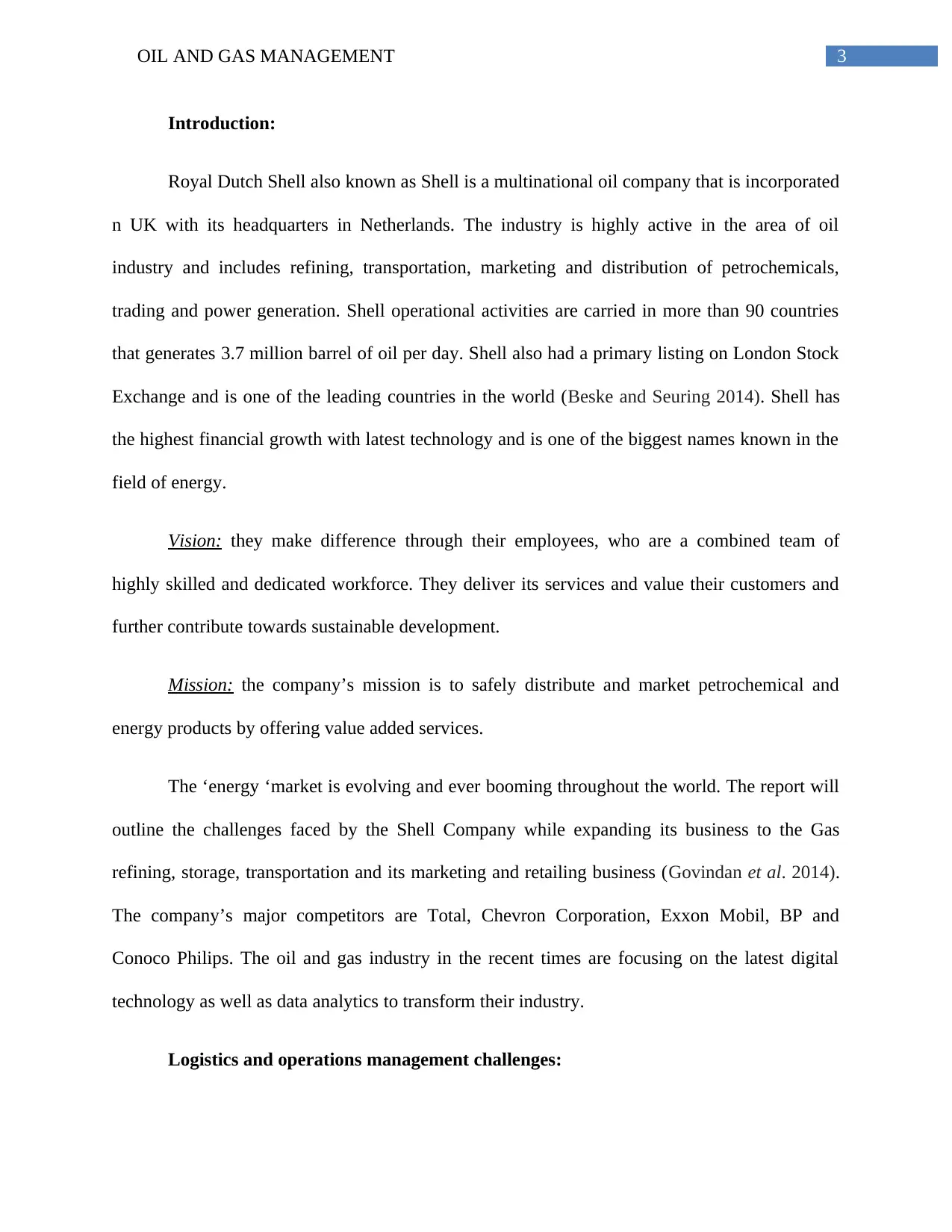
3OIL AND GAS MANAGEMENT
Introduction:
Royal Dutch Shell also known as Shell is a multinational oil company that is incorporated
n UK with its headquarters in Netherlands. The industry is highly active in the area of oil
industry and includes refining, transportation, marketing and distribution of petrochemicals,
trading and power generation. Shell operational activities are carried in more than 90 countries
that generates 3.7 million barrel of oil per day. Shell also had a primary listing on London Stock
Exchange and is one of the leading countries in the world (Beske and Seuring 2014). Shell has
the highest financial growth with latest technology and is one of the biggest names known in the
field of energy.
Vision: they make difference through their employees, who are a combined team of
highly skilled and dedicated workforce. They deliver its services and value their customers and
further contribute towards sustainable development.
Mission: the company’s mission is to safely distribute and market petrochemical and
energy products by offering value added services.
The ‘energy ‘market is evolving and ever booming throughout the world. The report will
outline the challenges faced by the Shell Company while expanding its business to the Gas
refining, storage, transportation and its marketing and retailing business (Govindan et al. 2014).
The company’s major competitors are Total, Chevron Corporation, Exxon Mobil, BP and
Conoco Philips. The oil and gas industry in the recent times are focusing on the latest digital
technology as well as data analytics to transform their industry.
Logistics and operations management challenges:
Introduction:
Royal Dutch Shell also known as Shell is a multinational oil company that is incorporated
n UK with its headquarters in Netherlands. The industry is highly active in the area of oil
industry and includes refining, transportation, marketing and distribution of petrochemicals,
trading and power generation. Shell operational activities are carried in more than 90 countries
that generates 3.7 million barrel of oil per day. Shell also had a primary listing on London Stock
Exchange and is one of the leading countries in the world (Beske and Seuring 2014). Shell has
the highest financial growth with latest technology and is one of the biggest names known in the
field of energy.
Vision: they make difference through their employees, who are a combined team of
highly skilled and dedicated workforce. They deliver its services and value their customers and
further contribute towards sustainable development.
Mission: the company’s mission is to safely distribute and market petrochemical and
energy products by offering value added services.
The ‘energy ‘market is evolving and ever booming throughout the world. The report will
outline the challenges faced by the Shell Company while expanding its business to the Gas
refining, storage, transportation and its marketing and retailing business (Govindan et al. 2014).
The company’s major competitors are Total, Chevron Corporation, Exxon Mobil, BP and
Conoco Philips. The oil and gas industry in the recent times are focusing on the latest digital
technology as well as data analytics to transform their industry.
Logistics and operations management challenges:
Secure Best Marks with AI Grader
Need help grading? Try our AI Grader for instant feedback on your assignments.
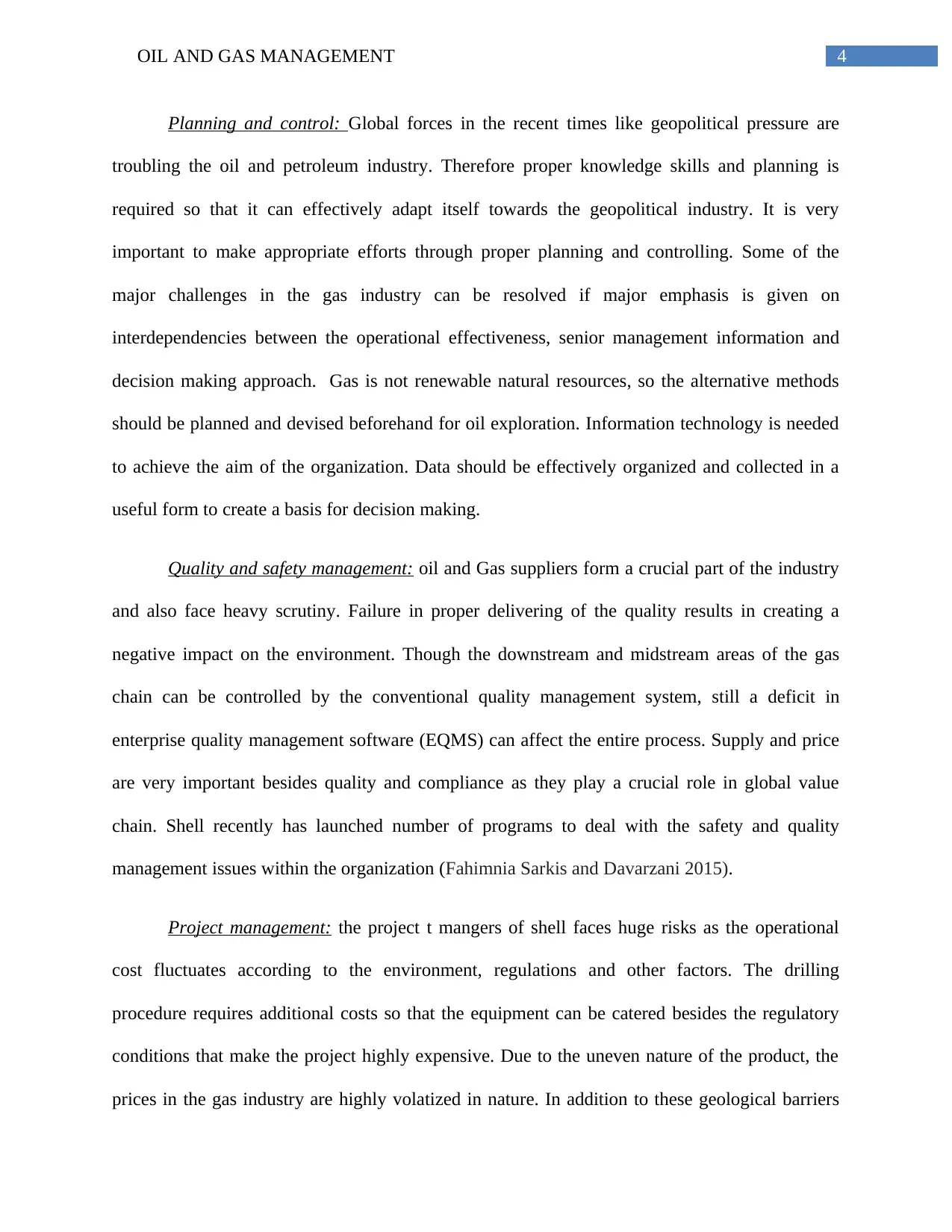
4OIL AND GAS MANAGEMENT
Planning and control: Global forces in the recent times like geopolitical pressure are
troubling the oil and petroleum industry. Therefore proper knowledge skills and planning is
required so that it can effectively adapt itself towards the geopolitical industry. It is very
important to make appropriate efforts through proper planning and controlling. Some of the
major challenges in the gas industry can be resolved if major emphasis is given on
interdependencies between the operational effectiveness, senior management information and
decision making approach. Gas is not renewable natural resources, so the alternative methods
should be planned and devised beforehand for oil exploration. Information technology is needed
to achieve the aim of the organization. Data should be effectively organized and collected in a
useful form to create a basis for decision making.
Quality and safety management: oil and Gas suppliers form a crucial part of the industry
and also face heavy scrutiny. Failure in proper delivering of the quality results in creating a
negative impact on the environment. Though the downstream and midstream areas of the gas
chain can be controlled by the conventional quality management system, still a deficit in
enterprise quality management software (EQMS) can affect the entire process. Supply and price
are very important besides quality and compliance as they play a crucial role in global value
chain. Shell recently has launched number of programs to deal with the safety and quality
management issues within the organization (Fahimnia Sarkis and Davarzani 2015).
Project management: the project t mangers of shell faces huge risks as the operational
cost fluctuates according to the environment, regulations and other factors. The drilling
procedure requires additional costs so that the equipment can be catered besides the regulatory
conditions that make the project highly expensive. Due to the uneven nature of the product, the
prices in the gas industry are highly volatized in nature. In addition to these geological barriers
Planning and control: Global forces in the recent times like geopolitical pressure are
troubling the oil and petroleum industry. Therefore proper knowledge skills and planning is
required so that it can effectively adapt itself towards the geopolitical industry. It is very
important to make appropriate efforts through proper planning and controlling. Some of the
major challenges in the gas industry can be resolved if major emphasis is given on
interdependencies between the operational effectiveness, senior management information and
decision making approach. Gas is not renewable natural resources, so the alternative methods
should be planned and devised beforehand for oil exploration. Information technology is needed
to achieve the aim of the organization. Data should be effectively organized and collected in a
useful form to create a basis for decision making.
Quality and safety management: oil and Gas suppliers form a crucial part of the industry
and also face heavy scrutiny. Failure in proper delivering of the quality results in creating a
negative impact on the environment. Though the downstream and midstream areas of the gas
chain can be controlled by the conventional quality management system, still a deficit in
enterprise quality management software (EQMS) can affect the entire process. Supply and price
are very important besides quality and compliance as they play a crucial role in global value
chain. Shell recently has launched number of programs to deal with the safety and quality
management issues within the organization (Fahimnia Sarkis and Davarzani 2015).
Project management: the project t mangers of shell faces huge risks as the operational
cost fluctuates according to the environment, regulations and other factors. The drilling
procedure requires additional costs so that the equipment can be catered besides the regulatory
conditions that make the project highly expensive. Due to the uneven nature of the product, the
prices in the gas industry are highly volatized in nature. In addition to these geological barriers
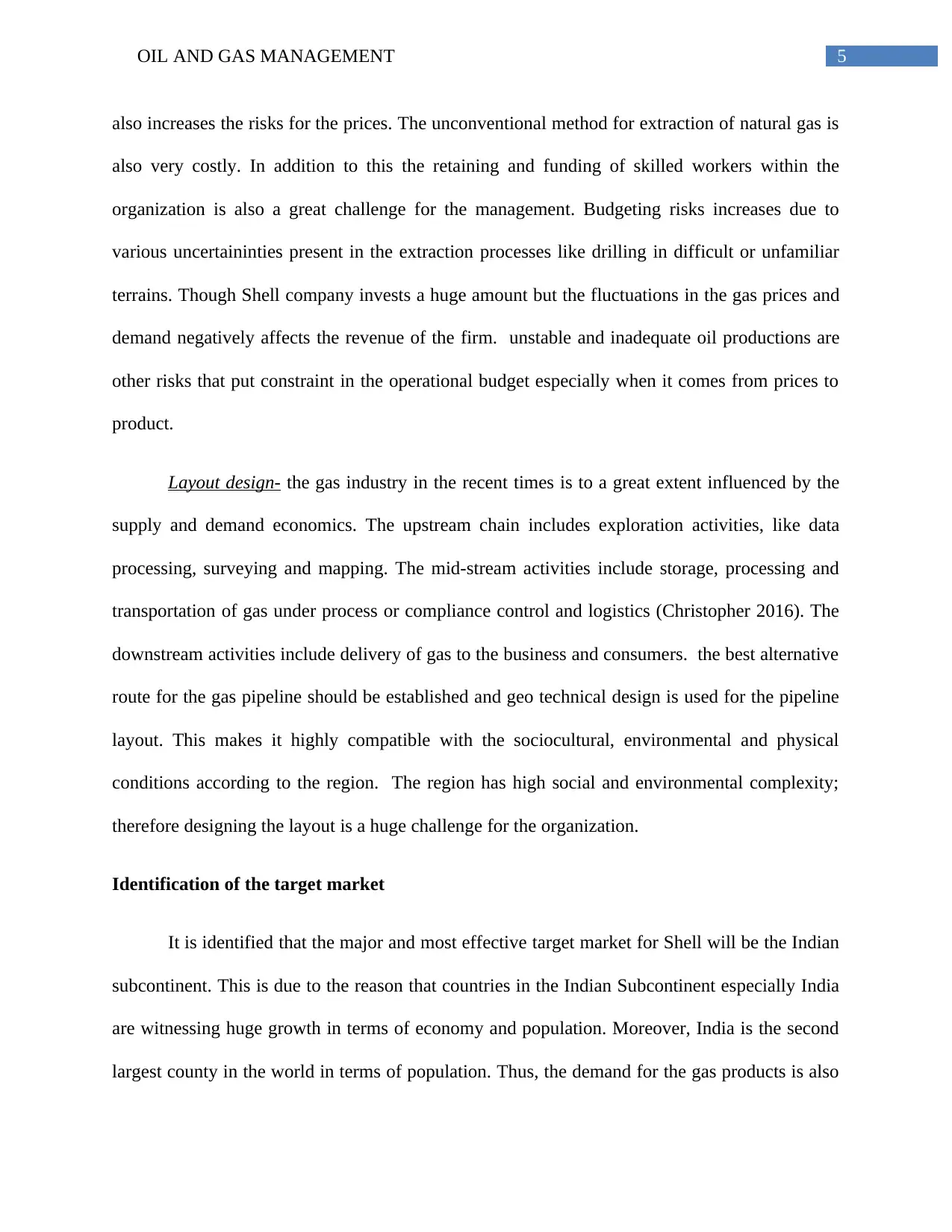
5OIL AND GAS MANAGEMENT
also increases the risks for the prices. The unconventional method for extraction of natural gas is
also very costly. In addition to this the retaining and funding of skilled workers within the
organization is also a great challenge for the management. Budgeting risks increases due to
various uncertaininties present in the extraction processes like drilling in difficult or unfamiliar
terrains. Though Shell company invests a huge amount but the fluctuations in the gas prices and
demand negatively affects the revenue of the firm. unstable and inadequate oil productions are
other risks that put constraint in the operational budget especially when it comes from prices to
product.
Layout design- the gas industry in the recent times is to a great extent influenced by the
supply and demand economics. The upstream chain includes exploration activities, like data
processing, surveying and mapping. The mid-stream activities include storage, processing and
transportation of gas under process or compliance control and logistics (Christopher 2016). The
downstream activities include delivery of gas to the business and consumers. the best alternative
route for the gas pipeline should be established and geo technical design is used for the pipeline
layout. This makes it highly compatible with the sociocultural, environmental and physical
conditions according to the region. The region has high social and environmental complexity;
therefore designing the layout is a huge challenge for the organization.
Identification of the target market
It is identified that the major and most effective target market for Shell will be the Indian
subcontinent. This is due to the reason that countries in the Indian Subcontinent especially India
are witnessing huge growth in terms of economy and population. Moreover, India is the second
largest county in the world in terms of population. Thus, the demand for the gas products is also
also increases the risks for the prices. The unconventional method for extraction of natural gas is
also very costly. In addition to this the retaining and funding of skilled workers within the
organization is also a great challenge for the management. Budgeting risks increases due to
various uncertaininties present in the extraction processes like drilling in difficult or unfamiliar
terrains. Though Shell company invests a huge amount but the fluctuations in the gas prices and
demand negatively affects the revenue of the firm. unstable and inadequate oil productions are
other risks that put constraint in the operational budget especially when it comes from prices to
product.
Layout design- the gas industry in the recent times is to a great extent influenced by the
supply and demand economics. The upstream chain includes exploration activities, like data
processing, surveying and mapping. The mid-stream activities include storage, processing and
transportation of gas under process or compliance control and logistics (Christopher 2016). The
downstream activities include delivery of gas to the business and consumers. the best alternative
route for the gas pipeline should be established and geo technical design is used for the pipeline
layout. This makes it highly compatible with the sociocultural, environmental and physical
conditions according to the region. The region has high social and environmental complexity;
therefore designing the layout is a huge challenge for the organization.
Identification of the target market
It is identified that the major and most effective target market for Shell will be the Indian
subcontinent. This is due to the reason that countries in the Indian Subcontinent especially India
are witnessing huge growth in terms of economy and population. Moreover, India is the second
largest county in the world in terms of population. Thus, the demand for the gas products is also
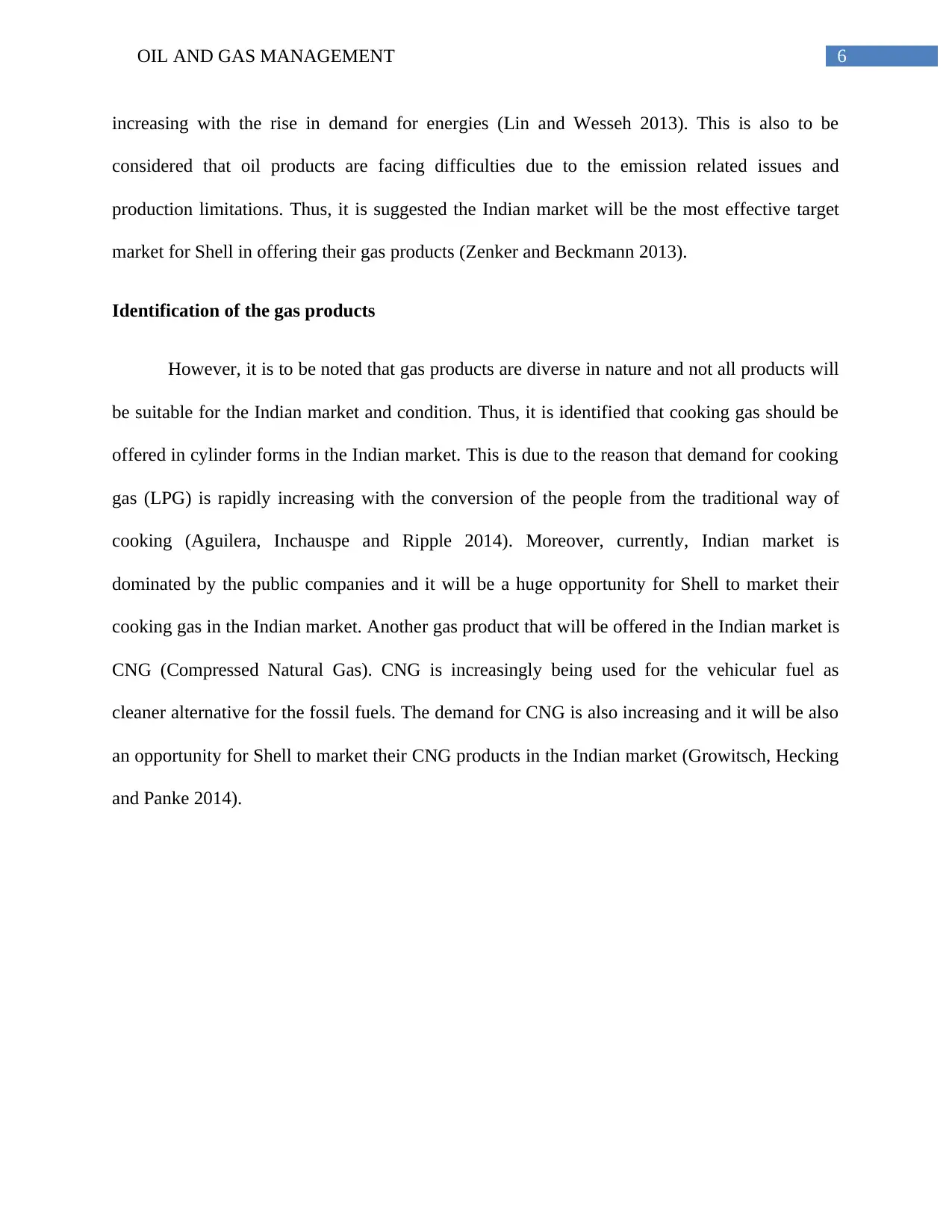
6OIL AND GAS MANAGEMENT
increasing with the rise in demand for energies (Lin and Wesseh 2013). This is also to be
considered that oil products are facing difficulties due to the emission related issues and
production limitations. Thus, it is suggested the Indian market will be the most effective target
market for Shell in offering their gas products (Zenker and Beckmann 2013).
Identification of the gas products
However, it is to be noted that gas products are diverse in nature and not all products will
be suitable for the Indian market and condition. Thus, it is identified that cooking gas should be
offered in cylinder forms in the Indian market. This is due to the reason that demand for cooking
gas (LPG) is rapidly increasing with the conversion of the people from the traditional way of
cooking (Aguilera, Inchauspe and Ripple 2014). Moreover, currently, Indian market is
dominated by the public companies and it will be a huge opportunity for Shell to market their
cooking gas in the Indian market. Another gas product that will be offered in the Indian market is
CNG (Compressed Natural Gas). CNG is increasingly being used for the vehicular fuel as
cleaner alternative for the fossil fuels. The demand for CNG is also increasing and it will be also
an opportunity for Shell to market their CNG products in the Indian market (Growitsch, Hecking
and Panke 2014).
increasing with the rise in demand for energies (Lin and Wesseh 2013). This is also to be
considered that oil products are facing difficulties due to the emission related issues and
production limitations. Thus, it is suggested the Indian market will be the most effective target
market for Shell in offering their gas products (Zenker and Beckmann 2013).
Identification of the gas products
However, it is to be noted that gas products are diverse in nature and not all products will
be suitable for the Indian market and condition. Thus, it is identified that cooking gas should be
offered in cylinder forms in the Indian market. This is due to the reason that demand for cooking
gas (LPG) is rapidly increasing with the conversion of the people from the traditional way of
cooking (Aguilera, Inchauspe and Ripple 2014). Moreover, currently, Indian market is
dominated by the public companies and it will be a huge opportunity for Shell to market their
cooking gas in the Indian market. Another gas product that will be offered in the Indian market is
CNG (Compressed Natural Gas). CNG is increasingly being used for the vehicular fuel as
cleaner alternative for the fossil fuels. The demand for CNG is also increasing and it will be also
an opportunity for Shell to market their CNG products in the Indian market (Growitsch, Hecking
and Panke 2014).
Paraphrase This Document
Need a fresh take? Get an instant paraphrase of this document with our AI Paraphraser
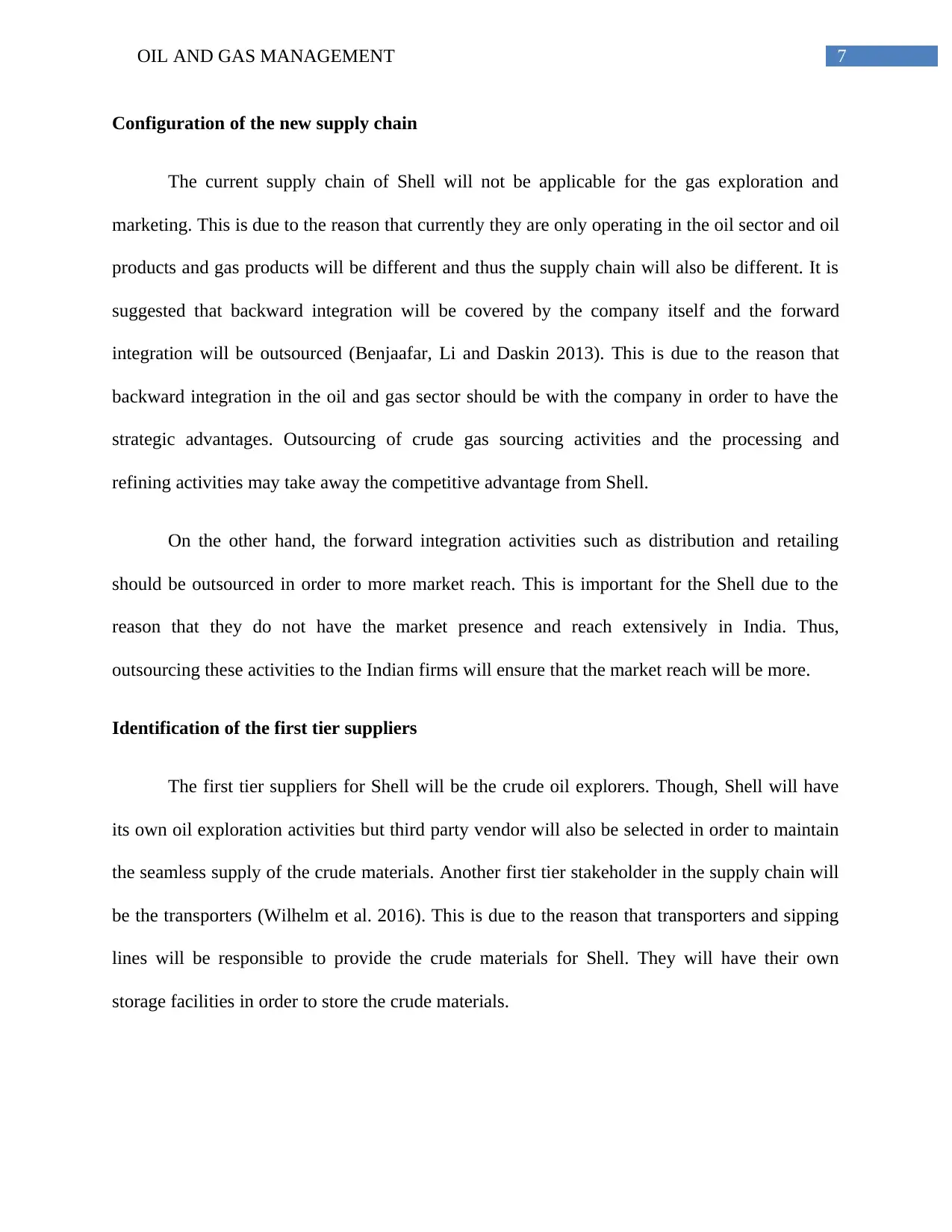
7OIL AND GAS MANAGEMENT
Configuration of the new supply chain
The current supply chain of Shell will not be applicable for the gas exploration and
marketing. This is due to the reason that currently they are only operating in the oil sector and oil
products and gas products will be different and thus the supply chain will also be different. It is
suggested that backward integration will be covered by the company itself and the forward
integration will be outsourced (Benjaafar, Li and Daskin 2013). This is due to the reason that
backward integration in the oil and gas sector should be with the company in order to have the
strategic advantages. Outsourcing of crude gas sourcing activities and the processing and
refining activities may take away the competitive advantage from Shell.
On the other hand, the forward integration activities such as distribution and retailing
should be outsourced in order to more market reach. This is important for the Shell due to the
reason that they do not have the market presence and reach extensively in India. Thus,
outsourcing these activities to the Indian firms will ensure that the market reach will be more.
Identification of the first tier suppliers
The first tier suppliers for Shell will be the crude oil explorers. Though, Shell will have
its own oil exploration activities but third party vendor will also be selected in order to maintain
the seamless supply of the crude materials. Another first tier stakeholder in the supply chain will
be the transporters (Wilhelm et al. 2016). This is due to the reason that transporters and sipping
lines will be responsible to provide the crude materials for Shell. They will have their own
storage facilities in order to store the crude materials.
Configuration of the new supply chain
The current supply chain of Shell will not be applicable for the gas exploration and
marketing. This is due to the reason that currently they are only operating in the oil sector and oil
products and gas products will be different and thus the supply chain will also be different. It is
suggested that backward integration will be covered by the company itself and the forward
integration will be outsourced (Benjaafar, Li and Daskin 2013). This is due to the reason that
backward integration in the oil and gas sector should be with the company in order to have the
strategic advantages. Outsourcing of crude gas sourcing activities and the processing and
refining activities may take away the competitive advantage from Shell.
On the other hand, the forward integration activities such as distribution and retailing
should be outsourced in order to more market reach. This is important for the Shell due to the
reason that they do not have the market presence and reach extensively in India. Thus,
outsourcing these activities to the Indian firms will ensure that the market reach will be more.
Identification of the first tier suppliers
The first tier suppliers for Shell will be the crude oil explorers. Though, Shell will have
its own oil exploration activities but third party vendor will also be selected in order to maintain
the seamless supply of the crude materials. Another first tier stakeholder in the supply chain will
be the transporters (Wilhelm et al. 2016). This is due to the reason that transporters and sipping
lines will be responsible to provide the crude materials for Shell. They will have their own
storage facilities in order to store the crude materials.
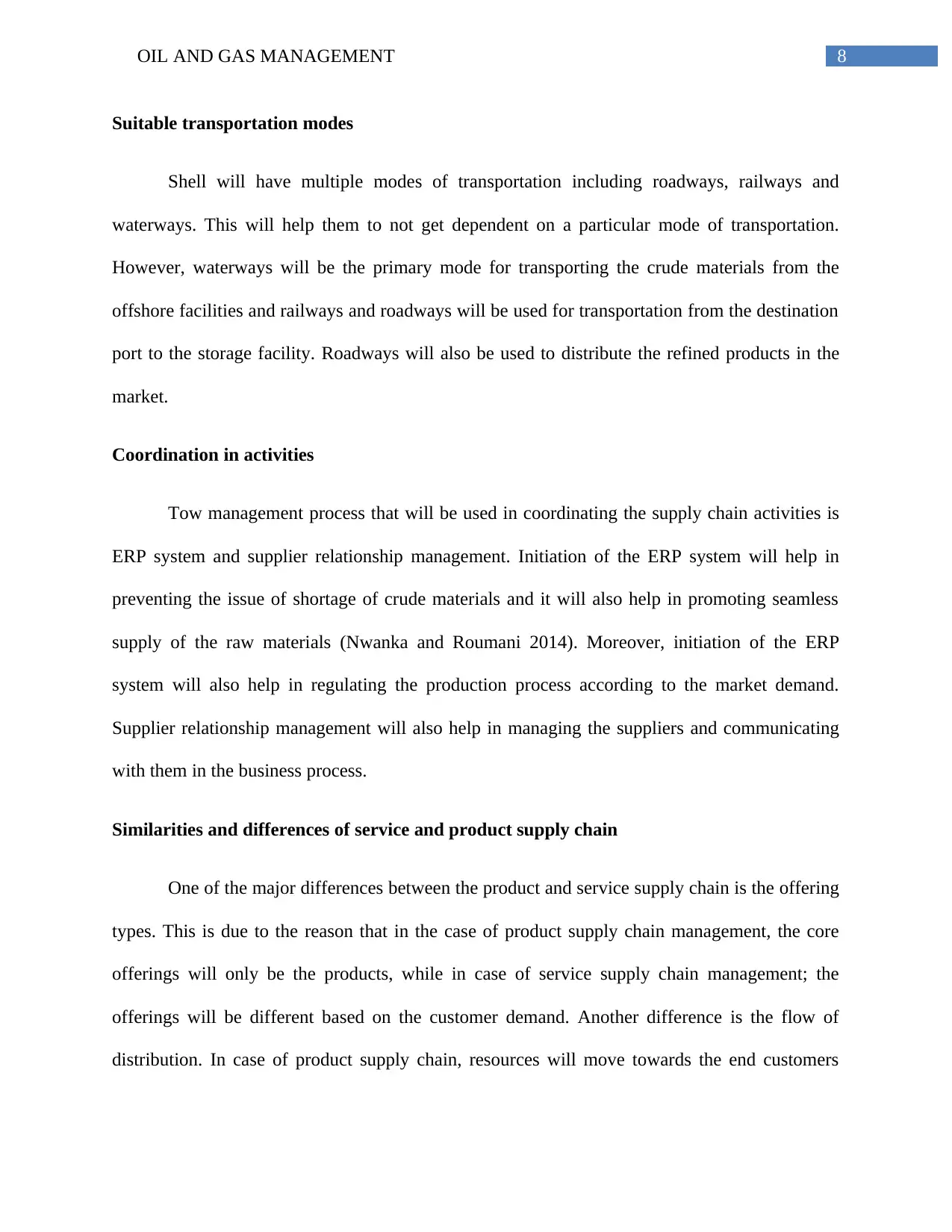
8OIL AND GAS MANAGEMENT
Suitable transportation modes
Shell will have multiple modes of transportation including roadways, railways and
waterways. This will help them to not get dependent on a particular mode of transportation.
However, waterways will be the primary mode for transporting the crude materials from the
offshore facilities and railways and roadways will be used for transportation from the destination
port to the storage facility. Roadways will also be used to distribute the refined products in the
market.
Coordination in activities
Tow management process that will be used in coordinating the supply chain activities is
ERP system and supplier relationship management. Initiation of the ERP system will help in
preventing the issue of shortage of crude materials and it will also help in promoting seamless
supply of the raw materials (Nwanka and Roumani 2014). Moreover, initiation of the ERP
system will also help in regulating the production process according to the market demand.
Supplier relationship management will also help in managing the suppliers and communicating
with them in the business process.
Similarities and differences of service and product supply chain
One of the major differences between the product and service supply chain is the offering
types. This is due to the reason that in the case of product supply chain management, the core
offerings will only be the products, while in case of service supply chain management; the
offerings will be different based on the customer demand. Another difference is the flow of
distribution. In case of product supply chain, resources will move towards the end customers
Suitable transportation modes
Shell will have multiple modes of transportation including roadways, railways and
waterways. This will help them to not get dependent on a particular mode of transportation.
However, waterways will be the primary mode for transporting the crude materials from the
offshore facilities and railways and roadways will be used for transportation from the destination
port to the storage facility. Roadways will also be used to distribute the refined products in the
market.
Coordination in activities
Tow management process that will be used in coordinating the supply chain activities is
ERP system and supplier relationship management. Initiation of the ERP system will help in
preventing the issue of shortage of crude materials and it will also help in promoting seamless
supply of the raw materials (Nwanka and Roumani 2014). Moreover, initiation of the ERP
system will also help in regulating the production process according to the market demand.
Supplier relationship management will also help in managing the suppliers and communicating
with them in the business process.
Similarities and differences of service and product supply chain
One of the major differences between the product and service supply chain is the offering
types. This is due to the reason that in the case of product supply chain management, the core
offerings will only be the products, while in case of service supply chain management; the
offerings will be different based on the customer demand. Another difference is the flow of
distribution. In case of product supply chain, resources will move towards the end customers

9OIL AND GAS MANAGEMENT
only. On the other hand, service supply chain witnesses reverse logistics and movement in
opposite direction.
The major similarity between the two supply chains is the importance of the end
customers. This is due to the fact that core objective of both the supply chain is to maximize the
value for the end customers.
Identification of hazards
One of the major issues will be the exposure of the employees towards hazardous gases
and chemicals. This is due to reason that exploration and refining crude gas will lead to
emergence of hazardous gases. Another mental issue that may be faced by the employees is the
monotony in the offshore facilities. In this case, job rotation should be initiated in order to put
them in different responsibilities. Job design should also be initiated in order to have more
variances in job profile for the employees.
Technologies such as drones will be used in order to identify the potential issues in the
offshore facilities. Moreover, all the employees will be covered with an online live portal where
they will be able to communicate with each other regarding their issues.
Conclusion and Recommendation:
Shell industry while expanding its business should also consider facing various risks and
challenges that includes fluctuations in the demand and supply to the technical falls and
deficiencies. T is recommended that the company should comply with the environmental and
safety regulations that confine the company’s operational activities to a certain limit. it is
only. On the other hand, service supply chain witnesses reverse logistics and movement in
opposite direction.
The major similarity between the two supply chains is the importance of the end
customers. This is due to the fact that core objective of both the supply chain is to maximize the
value for the end customers.
Identification of hazards
One of the major issues will be the exposure of the employees towards hazardous gases
and chemicals. This is due to reason that exploration and refining crude gas will lead to
emergence of hazardous gases. Another mental issue that may be faced by the employees is the
monotony in the offshore facilities. In this case, job rotation should be initiated in order to put
them in different responsibilities. Job design should also be initiated in order to have more
variances in job profile for the employees.
Technologies such as drones will be used in order to identify the potential issues in the
offshore facilities. Moreover, all the employees will be covered with an online live portal where
they will be able to communicate with each other regarding their issues.
Conclusion and Recommendation:
Shell industry while expanding its business should also consider facing various risks and
challenges that includes fluctuations in the demand and supply to the technical falls and
deficiencies. T is recommended that the company should comply with the environmental and
safety regulations that confine the company’s operational activities to a certain limit. it is
Secure Best Marks with AI Grader
Need help grading? Try our AI Grader for instant feedback on your assignments.
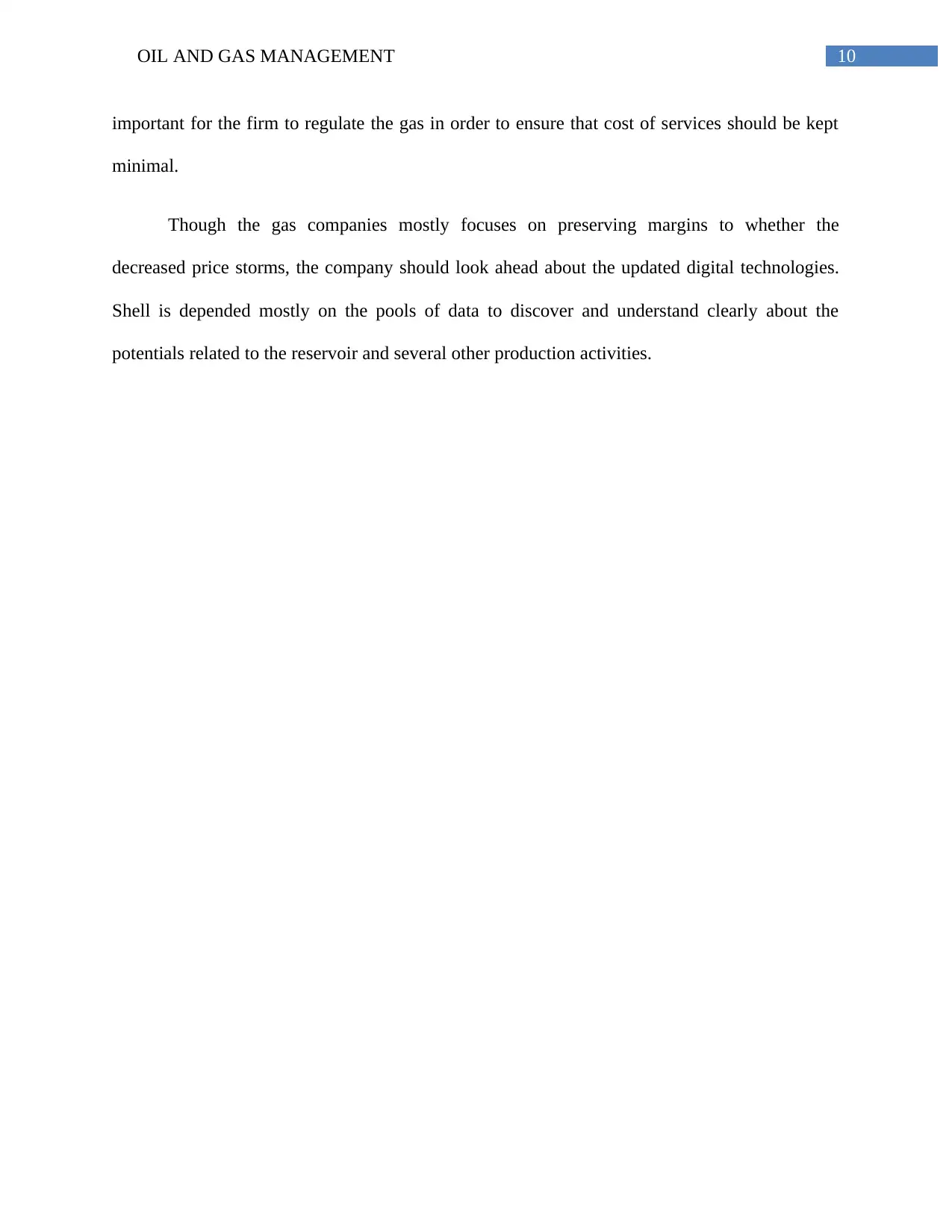
10OIL AND GAS MANAGEMENT
important for the firm to regulate the gas in order to ensure that cost of services should be kept
minimal.
Though the gas companies mostly focuses on preserving margins to whether the
decreased price storms, the company should look ahead about the updated digital technologies.
Shell is depended mostly on the pools of data to discover and understand clearly about the
potentials related to the reservoir and several other production activities.
important for the firm to regulate the gas in order to ensure that cost of services should be kept
minimal.
Though the gas companies mostly focuses on preserving margins to whether the
decreased price storms, the company should look ahead about the updated digital technologies.
Shell is depended mostly on the pools of data to discover and understand clearly about the
potentials related to the reservoir and several other production activities.
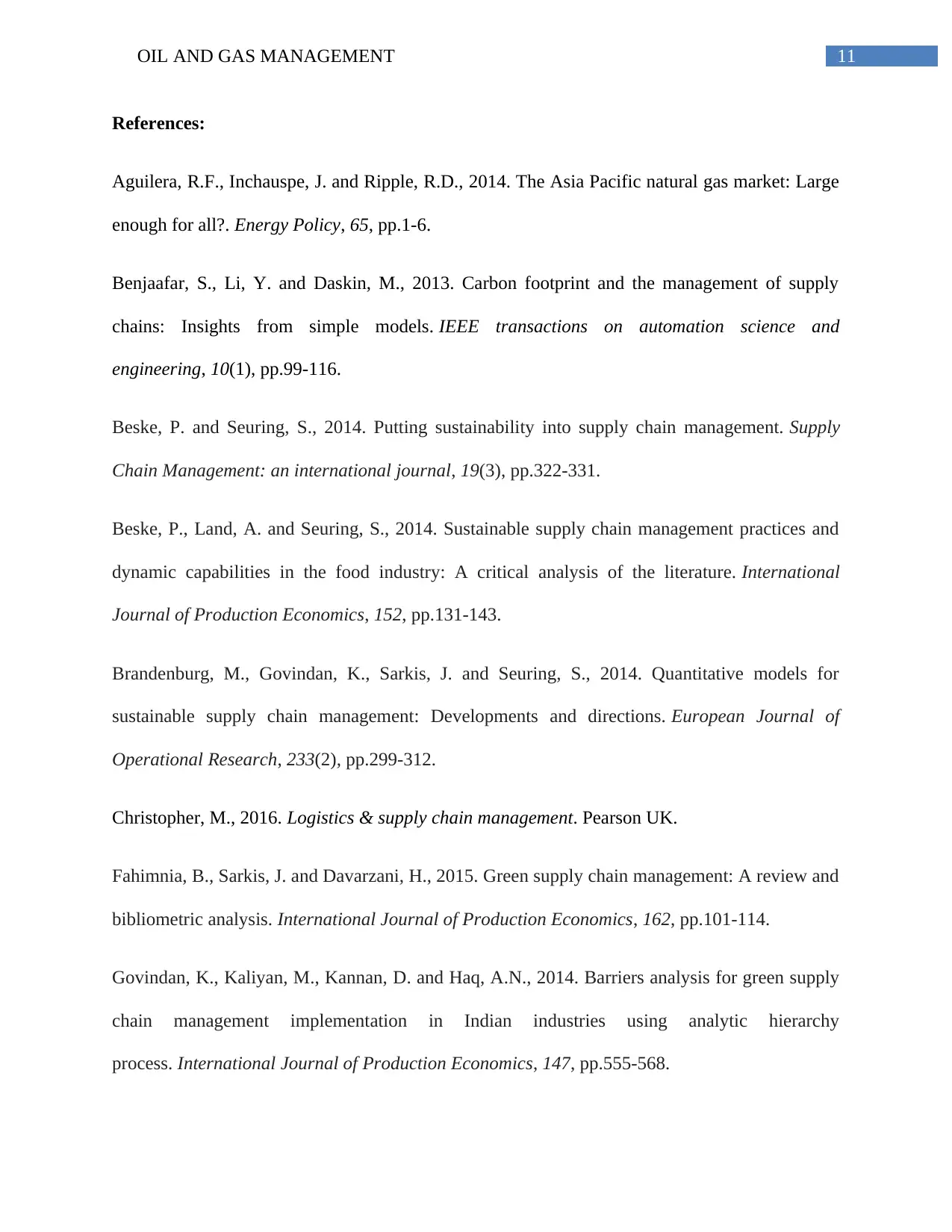
11OIL AND GAS MANAGEMENT
References:
Aguilera, R.F., Inchauspe, J. and Ripple, R.D., 2014. The Asia Pacific natural gas market: Large
enough for all?. Energy Policy, 65, pp.1-6.
Benjaafar, S., Li, Y. and Daskin, M., 2013. Carbon footprint and the management of supply
chains: Insights from simple models. IEEE transactions on automation science and
engineering, 10(1), pp.99-116.
Beske, P. and Seuring, S., 2014. Putting sustainability into supply chain management. Supply
Chain Management: an international journal, 19(3), pp.322-331.
Beske, P., Land, A. and Seuring, S., 2014. Sustainable supply chain management practices and
dynamic capabilities in the food industry: A critical analysis of the literature. International
Journal of Production Economics, 152, pp.131-143.
Brandenburg, M., Govindan, K., Sarkis, J. and Seuring, S., 2014. Quantitative models for
sustainable supply chain management: Developments and directions. European Journal of
Operational Research, 233(2), pp.299-312.
Christopher, M., 2016. Logistics & supply chain management. Pearson UK.
Fahimnia, B., Sarkis, J. and Davarzani, H., 2015. Green supply chain management: A review and
bibliometric analysis. International Journal of Production Economics, 162, pp.101-114.
Govindan, K., Kaliyan, M., Kannan, D. and Haq, A.N., 2014. Barriers analysis for green supply
chain management implementation in Indian industries using analytic hierarchy
process. International Journal of Production Economics, 147, pp.555-568.
References:
Aguilera, R.F., Inchauspe, J. and Ripple, R.D., 2014. The Asia Pacific natural gas market: Large
enough for all?. Energy Policy, 65, pp.1-6.
Benjaafar, S., Li, Y. and Daskin, M., 2013. Carbon footprint and the management of supply
chains: Insights from simple models. IEEE transactions on automation science and
engineering, 10(1), pp.99-116.
Beske, P. and Seuring, S., 2014. Putting sustainability into supply chain management. Supply
Chain Management: an international journal, 19(3), pp.322-331.
Beske, P., Land, A. and Seuring, S., 2014. Sustainable supply chain management practices and
dynamic capabilities in the food industry: A critical analysis of the literature. International
Journal of Production Economics, 152, pp.131-143.
Brandenburg, M., Govindan, K., Sarkis, J. and Seuring, S., 2014. Quantitative models for
sustainable supply chain management: Developments and directions. European Journal of
Operational Research, 233(2), pp.299-312.
Christopher, M., 2016. Logistics & supply chain management. Pearson UK.
Fahimnia, B., Sarkis, J. and Davarzani, H., 2015. Green supply chain management: A review and
bibliometric analysis. International Journal of Production Economics, 162, pp.101-114.
Govindan, K., Kaliyan, M., Kannan, D. and Haq, A.N., 2014. Barriers analysis for green supply
chain management implementation in Indian industries using analytic hierarchy
process. International Journal of Production Economics, 147, pp.555-568.
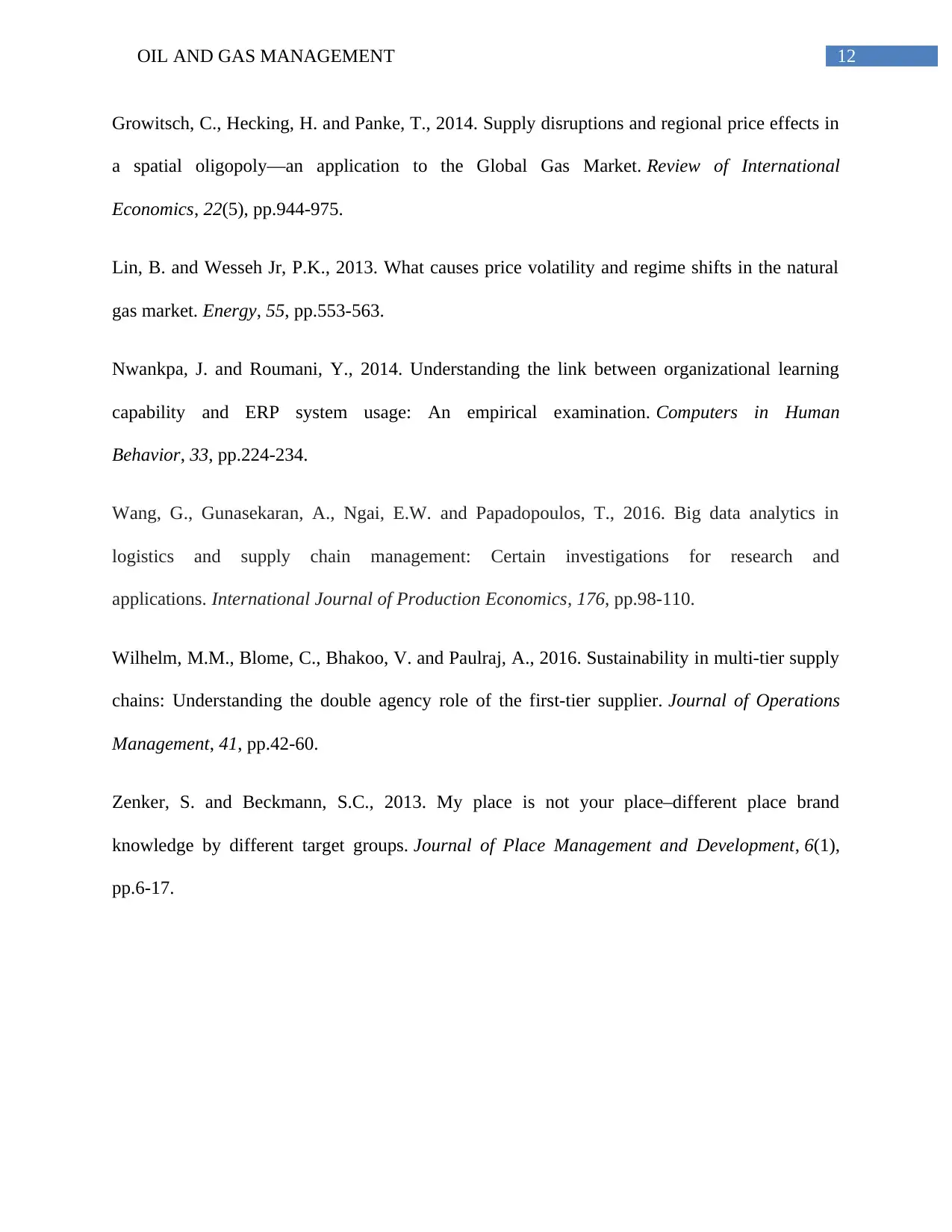
12OIL AND GAS MANAGEMENT
Growitsch, C., Hecking, H. and Panke, T., 2014. Supply disruptions and regional price effects in
a spatial oligopoly—an application to the Global Gas Market. Review of International
Economics, 22(5), pp.944-975.
Lin, B. and Wesseh Jr, P.K., 2013. What causes price volatility and regime shifts in the natural
gas market. Energy, 55, pp.553-563.
Nwankpa, J. and Roumani, Y., 2014. Understanding the link between organizational learning
capability and ERP system usage: An empirical examination. Computers in Human
Behavior, 33, pp.224-234.
Wang, G., Gunasekaran, A., Ngai, E.W. and Papadopoulos, T., 2016. Big data analytics in
logistics and supply chain management: Certain investigations for research and
applications. International Journal of Production Economics, 176, pp.98-110.
Wilhelm, M.M., Blome, C., Bhakoo, V. and Paulraj, A., 2016. Sustainability in multi-tier supply
chains: Understanding the double agency role of the first-tier supplier. Journal of Operations
Management, 41, pp.42-60.
Zenker, S. and Beckmann, S.C., 2013. My place is not your place–different place brand
knowledge by different target groups. Journal of Place Management and Development, 6(1),
pp.6-17.
Growitsch, C., Hecking, H. and Panke, T., 2014. Supply disruptions and regional price effects in
a spatial oligopoly—an application to the Global Gas Market. Review of International
Economics, 22(5), pp.944-975.
Lin, B. and Wesseh Jr, P.K., 2013. What causes price volatility and regime shifts in the natural
gas market. Energy, 55, pp.553-563.
Nwankpa, J. and Roumani, Y., 2014. Understanding the link between organizational learning
capability and ERP system usage: An empirical examination. Computers in Human
Behavior, 33, pp.224-234.
Wang, G., Gunasekaran, A., Ngai, E.W. and Papadopoulos, T., 2016. Big data analytics in
logistics and supply chain management: Certain investigations for research and
applications. International Journal of Production Economics, 176, pp.98-110.
Wilhelm, M.M., Blome, C., Bhakoo, V. and Paulraj, A., 2016. Sustainability in multi-tier supply
chains: Understanding the double agency role of the first-tier supplier. Journal of Operations
Management, 41, pp.42-60.
Zenker, S. and Beckmann, S.C., 2013. My place is not your place–different place brand
knowledge by different target groups. Journal of Place Management and Development, 6(1),
pp.6-17.
1 out of 13
Related Documents
Your All-in-One AI-Powered Toolkit for Academic Success.
+13062052269
info@desklib.com
Available 24*7 on WhatsApp / Email
![[object Object]](/_next/static/media/star-bottom.7253800d.svg)
Unlock your academic potential
© 2024 | Zucol Services PVT LTD | All rights reserved.





